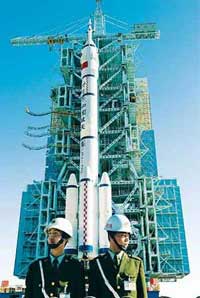|
Shenzhou VI set to take off this morning
(chinadaily.com.cn/Agencies)
Updated: 2005-10-11 15:59

Shenzhou VI, a
spaceship to carry two astronauts into orbit, sits atop of the LM-2F
carrier rocket at the launching pad in Jiuquan satellite launch center in
northwest China October 7, 2005. It is widely reported that China's second
manned spaceship will be launched on October 13. [Nanfang
Daily] | They will also for the first time carry
out "scientific experiments with human participation in its real sense" in
space.
Liu Yu, commander in chief of the rocket system, said the rocket for
Shenzhou-VI has much improvement in reliability and safety compared with the one
for Shenzhou-V. "We have confidence in the quality of this rocket. We have the
conditions and capability to fulfill this mission," Liu said.
"The Chinese should be very proud of what they are accomplishing," AFP quoted
David Baker, a London-based space policy analyst for Jane's Defence Weekly, as
saying. "It's the kind of activity that only a developed and well-organized
industrial nation can pull off."
While the Shenzhou technology is based on 1950s and 1960s Soviet science,
analysts said it would be wrong to shrug off China's space program.
"If it was easy, China wouldn't be the third country with a manned program,"
said Joan Johnson-Freese, an expert on China's space program at the US Naval War
College.
"The technology isn't exactly breakthrough technology, but being able to put
it all together and make it work, is sending a message that in fact China has
integration skills, it has follow-through capability to build this kind of
technology."
The Shenzhou spacecraft, based on the robust and thoroughly tested Soviet
design for the Soyuz vessel, is basically the same this time as two years ago.
It consists of three modules -- the orbital module where scientific
experiments are carried out; the re-entry capsule where the astronauts will
spend most of their time; and the service module, which contains fuel and air,
solar panels and other technical gear.
During his 21-hour trip to space in 2003, Yang never left the re-entry
capsule, but this time will be different.
The two astronauts will enter into the orbital module in the front to conduct
a large number of tests, presumably designed to check their physical reactions
to conditions in space.
"This is very, very typical of the Chinese space program," said Brian Harvey,
the Dublin-based author of a book on China's space endeavors. "They go quite a
big step each time. They very rarely repeat missions."
"The answer really lies in prestige first, direct economic and social
applications second, and using the space program as a cutting-edge tool for
technology third," said Harvey.
"China will never be a superpower, but as the world's biggest developing
country with 1.3 billion people, it should have a place in aerospace development
and make due contributions," Wang Yongzhi, chief designer of the national manned
space flight program, was quoted as saying.
|